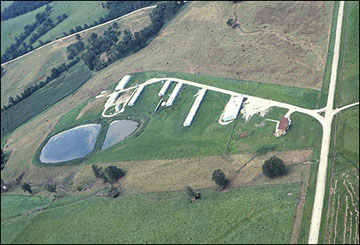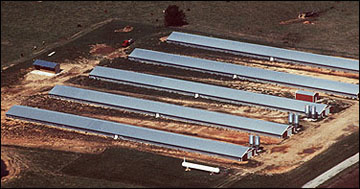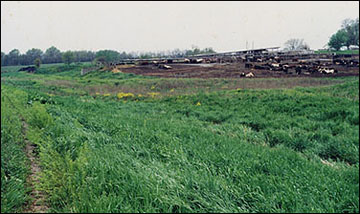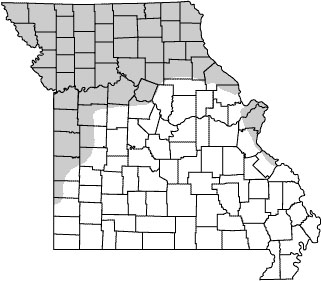
The first factor to consider in selecting a site for an animal feeding operation is state and local permitting requirements and ordinances. Consult local health and regulatory authorities and have all plans approved before constructing any manure handling system. Contact the Water Protection Program(opens in new window) at the Missouri Department of Natural Resources at 800-361-4827 for information regarding Concentrated Animal Feeding Operation (CAFO) permits. For assistance in planning manure management systems, see your local MU Extension center or the Natural Resources Conservation Service (NRCS). Consider seeking professional assistance for selection of a site for an animal feeding operation.
Other factors to consider in selecting a site for a new or expanded livestock operation include the following:
- Distance to neighboring residences
- Direction of prevailing winds in relation to neighbors
- An adequate source of water
- Access to land for manure application
- Topography
- Soil type
- Proximity to surface water bodies, sinkholes and flood plains
- Depth to groundwater
Likelihood of odor complaints by neighbors may be a major deterrent to siting large livestock operations in many locations.
Determine the attitude of neighbors toward a new or expanded livestock operation at the site you are considering. Documenting that adequate consideration has been given to siting the livestock operation in an environmentally responsible manner may help if litigation occurs.
Odors are inherent in livestock operations, especially when manure is being applied to the land. The larger the livestock operation, the more important it is to plan, design, construct and operate the facility in a manner that will minimize off-site (and on-site) odors. It is important to control sufficient land to provide an adequate buffer between neighbors and the more odoriferous locations at the livestock facility (Figure 1). Odors from large livestock production units may be noticeable a few miles away.
 Figure 1
Figure 1
A livestock feeding operation site should be selected to minimize visual contact with neighbors and traffic and to separate odor-producing facilities from neighbors.
Biosecurity considerations should include isolation for incoming seedstock, proximity of neighboring livestock production units (especially for production of breeding stock), and, possibly, multiple-site production.
Very large livestock operations should be isolated from residential areas — such as villages and towns — by two miles or more, if possible.
(opens in new window)Space considerations
Plan for expansion 20 to 30 years into the future; consider doubling the size anticipated at present. Avoid locating facilities near property lines, streams, steep topography, porous geology, housing developments, public-use areas, or other features that will limit expansion. Additionally, buildings should be spaced at least 50 feet apart (75 feet is better for firetrucks) to reduce the spread of fire. Naturally ventilated buildings may need to be from 50 to 200 feet apart in the north-south direction for optimum summer airflow (Figure 2). Considerable space may be needed for isolating incoming traffic from the animal areas to prevent the spreading of diseases that may be brought in from the outside. The minimum radius for driveways used by semitrailers is approximately 55 feet.
 Figure 2
Figure 2
The naturally ventilated livestock buildings at this facility are spaced to allow for summertime air flow.
(opens in new window)Proximity of neighbors
Avoid placing livestock facilities near existing (or future) “non-owned residences” (residences not owned by the owners of the animal feeding operation), especially clusters of homes, built-up areas and parks. Preferably, livestock facilities should be out of your neighbors’ sight. Consider having a tree windbreak or other visual barrier to shield the operation. Depending on the size of the facility, the minimum distance from non-owned residences should be from 1,000 to 3,000 feet, although this is no guarantee of immunity from complaints. A separation of at least a mile may be needed between large livestock operations and non-owned residences, depending on such considerations as topography and prevailing wind direction.
(opens in new window)Classification of animal feeding operations
The state of Missouri has passed an environmental law that establishes four classes of concentrated animal feeding operations (CAFOs) with buffer distances for each class, based on the number of animals that will occupy the operation (Table 1). These distances are for design and construction of new or modified concentrated animal feeding operations and are the minimum buffer distances required between the nearest confinement building or lagoon and any public building or occupied residence.
Table 1. Animal unit, size classification, buffer distances and permit requirements (permits required for all Class I CAFOs).
| Class | Animal units | Buffer distance |
|---|---|---|
| Class IA* | 7,000 and up | 3,000 feet |
| Class IB** | 3,000 to 6,999 | 2,000 feet |
| Class IC*** | 1,000 to 2,999 | 1,000 feet |
| Class II**** | 300 to 999 | ***** |
| *Class IA — Wet handling operations that have 50 percent or more moisture in the waste must obtain a site-specific permit (based on farm type and location). Dry handling operations that have less than 50 percent moisture in the waste must obtain a general permit. **Class IB — Wet or dry handling operations must obtain a general permit. ***Class IC — Wet or dry handling operations must obtain a general permit. ****Class II and smaller operations are those with less than 300 AU, and are not required to obtain coverage under a NPDES or State No-discharge Operating Permit. *****Buffer distance is not required unless part of a letter of approval or permit requirement. An animal unit of any species excretes manure equal to a 1,000 pounds beef animal. The buffer distance is measured from the facility to any non-owned, occupied dwelling or public building. |
||
(opens in new window)Missouri well setback distances
There were no Missouri well rules before September 1987. The well construction rules adopted after that date are summarized in Table 2. Wells constructed before the Missouri Well Construction Rules but after adoption of the Missouri Clean Water Commission rules for minimum separation distances are reviewed and approved on a case-by-case basis and may involve water sample testing or dye tracing for indications of contamination. Planned new operations are not approved if they are closer to existing wells than the minimum required distance shown in Table 2. If an animal feeding operation has a well that was installed after adoption of the current water well rules and does not meet the minimum separation distance requirements, the Missouri Department of Natural Resources may require modifications to the well or that a new well be drilled. The new amendments to the Missouri Well Construction Rules became effective June 30, 1996.
Table 2. Missouri well construction rules: Well setback distances since 1986 in accordance with Missouri Well Construction Code rule 10 CSR 23-3.010.
| Potential source of contamination | Setback distance | ||
|---|---|---|---|
| New wellsa | Older wells | ||
| 1994b | 1987c | ||
| Storage area for commercial fertilizer or chemicals | 300 feet | 300 feet | 150 feet |
| Cesspool | 100 feet | 100 feet | 100 feet |
| Below-grade manure storage area | 300 feet | 100 feet | 100 feet |
| Animal or poultry yard, building or privy | 100 feet | 100 feet | 75 feet |
| Other contaminants that may drain into the soil | 100 feet | 100 feet | 75 feet |
| Lagoon | 300 feet | 300 feet | Case-by-case |
| Earthen, concrete, or other manure storage structure or lagoons | 300 feet | d | d |
| Land application areas for animal waste | 300 feet | 300 feet | e |
| Uncovered animal composters | 300 feet | d | d |
| Enclosed composters with concrete floor and roof | 100 feet | d | d |
| Dry litter storage in poultry building during normal operations | 100 feet | d | d |
| Single family lagoon | 100 feet | d | d |
| a. Regulation effective June 30, 1996 b. Regulation effective Jan. 1, 1994 c. Regulation effective Nov. 1, 1987 d. Not covered by Missouri well construction rules, but Clean Water Commission rules recommend 300 feet and require a minimum of 100 feet. e. Not covered by Missouri well construction rules, but April 15, 1989, Clean Water Commission rules require a minimum of 300 feet. |
|||
(opens in new window)Winds and odor complaints
Desirable separation distance from odor sources such as production buildings, feedlots, manure storage structures, lagoons and land application areas is influenced by topography and prevailing wind. Because the timing of land application is somewhat flexible, manure can usually be applied when climatic conditions (wind direction, humidity) are most favorable. Fields in which manure is surface applied need greater separation than fields in which manure is injected. Fewer odor complaints about land application usually occur if the manure is treated in a lagoon, injected into the soil, or immediately incorporated into the soil by tillage. However, be sure any tillage operations are compatible with residue requirements of conservation plans.
Prevailing wind direction in relationship to non-owned residences is important, especially during seasons when neighbors will be outside. If local knowledge is not available, wind data is available from the National Oceanic and Atmospheric Administration or from the Midwest Plan Service Publication MWPS2, Farmstead Planning Handbook, which shows wind patterns for many locations during the months of January and July.
(opens in new window)Air drainage and odor complaints
During calm, humid periods, topography can funnel odors down drainage ways to distant locations, especially to residences located in valleys. Odors traveling in this way can remain intense over long distances. Topographical maps can show potential paths of air drainage. Remember, odors following drainage patterns may be more offensive than odors carried by prevailing winds.
(opens in new window)Geological problems
Soils with low permeability are desirable for earthen manure storages to prevent groundwater contamination. Much of the southern half of Missouri has highly permeable, gravelly, rocky, sandy or block-structured red clay soils that may allow wastes to seep into the groundwater. Soil surveys by the Natural Resources Conservation Service rate soils for many factors, including permeability, drainage and suitability for manure lagoons, road fill and irrigation. A soils investigation of the site is necessary to determine the availability of suitable clay for sealing earthen manure storage structures.
Parts of southern Missouri, as well as areas along the Mississippi River and the lower portion of the Missouri River have limestone deposits. These deposits may restrict the use of earthen manure impoundments because of potential groundwater pollution. Be cautious when planning animal feeding facilities in an area known to have sink holes and remember, if the facility site has a high potential for a subsurface collapse, Missouri Department of Natural Resources will not approve an earthen manure storage structure. In these cases, an alternate site must be selected, or a concrete or steel tank used for storage.
Shallow bedrock creates problems in the installation of underground utilities such as water, gas, or electric lines and may preclude the use of earthen storages for water or manure. A few hours of investigation with a backhoe or a drilling rig may be necessary to properly evaluate a site. All operations seeking a permit or a letter of approval must obtain a geologic evaluation of the site if an earthen manure storage is planned. A geologic evaluation of the site for any earthen manure storage is recommended. This service is provided by the Division of Geology and Land Survey, Missouri Department of Natural Resources, 573-368-2100.
(opens in new window)Streams and watercourses
Livestock facilities, especially open lots, should not be located close to streams and watercourses or on steep land along these areas. Runoff should be contained and applied to a soil/plant filter. Pastured livestock should be fenced out of streams along with a 50- to 300-foot wide grass, forest (or combination) filter strip. Limited access to the stream may be an alternative watering source for livestock
(opens in new window)Drainage
Good surface and subsurface drainage around livestock facilities is important, but polluted water must not leave the premises or enter the groundwater (Figure 3). Avoid building in a poorly drained site, on a flood plain or on sites with seeps, springs or a high water table.
 Figure 3
Figure 3
Open-lot systems should be located on well-drained sites and runoff should be controlled.
Dick Lee photo
Flood protection shall apply to new construction and to existing facilities undergoing major modification. The wastewater facility structures, electrical equipment, and mechanical equipment shall be protected from physical damage by no less than the 100-year flood elevation. The U.S. Army Corps of Engineers can supply data on 100-year flood levels. Additionally, the bottom of the storage structure must be located at least four feet above the water table.
Slopes of 2 to 5 percent will usually provide surface drainage without erosion, depending on the soil type. A 5 percent minimum slope away from building foundations is recommended, and south slopes are preferred for livestock feeding areas. Buildings built on high ground can take advantage of natural slopes for drainage and to obtain a 2 percent minimum slope on conduits to lagoons. On slopes it may be necessary to divert surface runoff from facilities. It is advisable to build roads along ridges to take advantage of drainage and reduce snow drifts.
(opens in new window)Accessibility
A livestock operation should have good access to markets, preferably by means of state-maintained, hard-surfaced highways with bridges permitting large trucks. Prompt snow removal is important. Avoid sites where the cost of constructing and maintaining the road from the livestock operation to the public road will be excessive because of distance, required bridges, snow drifting or other topographical or soils problems. This cost may be balanced against the need to provide setback or separation distance between the operation and potential odor receptors.
(opens in new window)Utilities
Water
A year-round supply of water is essential for the animals, sanitation, workers and residences and fire protection. Water may be needed for animal manure dilution and flush-cleaning facilities. Public water supplies are expensive for watering livestock. Water consumption varies greatly from winter to summer.
Tables 3 and 4 contain guidelines for daily drinking water requirements.
Table 3. Daily livestock water consumption.
| Animal type | Gallons per head per day | |
|---|---|---|
| Cold weather | Hot weather | |
| Cow/calf pairs | 13 | 30 to 35 |
| Dairy cows (lactating) | 29 to 35 | 35 to 45 |
| Dry cows | 13 to 16 | 20 to 30 |
| Calves (1 to 1.5 gallons per day per 100 pounds body weight) | 6 | 12 |
| Growing cattle, 400 to 800 pounds | 4 to 8 | 8 to 15 |
| Finishing cattle, 800 to 1200 pounds | 8 to 11 | 15 to 22 |
| Bred heifers (800 pounds) | 7 to 10 | 10 to 15 |
| Bulls (1500 pounds) | 14 | 30 |
| Sow and litter | 6 | 8 |
| Gestating sow, gilt, boar | 4 | 6 |
| Nursery pigs | 0.6 | 1 |
| Growing pigs | 2 | 3 |
| Finishing pigs | 4 | 5 |
| Feeder lambs (30 to 110 pounds) | 1.5 | |
| Dry ewes (150 to 200 pounds) | 1 | 2 |
| Ewes | 1 | 3 |
| Ewe with lambs (5 to 30 pounds) | 2 | 3.5 |
| Rams (180 to 300) | 2 | 3 |
| Horses | 8 | 12 |
Table 4. Daily water consumption per 100 birds for chickens and turkeys.
| Age | Gallons | |
|---|---|---|
| Chickens | 1 to 3 weeks | 0.6 to 1.8 |
| 6 to 10 weeks | 3.0 to 4.2 | |
| 9 to 13 weeks | 3.6 to 4.8 | |
| Laying hens, moderate temperatures | 4.8 to 7.2 | |
| Laying hens, 90 degrees | 8.4 | |
| Turkeys | 1 to 3 weeks | 7.8 to 18.0 |
| 9 to 13 weeks | 60 to 96 | |
| 15 to 19 weeks | 120 |
High-yield wells with acceptable water quality are not universally available in the northern one-third of Missouri (Figure 4). For further information about potential well yields and water quality for Missouri aquifers, contact the Water Resources Program, Division of Geology and Land Survey, Missouri Department of Natural Resources, 573-368-2190. Where high-capacity wells are not available, surface water supplies (ponds/lakes) are an alternative, especially for watering livestock and for cleaning operations. A standby water supply may be as desirable for a large livestock operation as is a standby electrical system.
 Figure 4
Figure 4
The shaded portion of this map indicates areas in which the more productive aquifers contain highly mineralized water.
Source
Missouri DNR, Division of Geology and Land Survey
A properly sealed, high-capacity, deep well is usually preferred. Shallow wells are more likely to become contaminated from surface runoff or deep percolation. The well(s) should be located away from possible contamination sources such as lagoons, livestock lots, septic tanks and septic fields. For deep wells with sealed casings that draw water from bedrock formations, the recommended distance from contamination sources is 300 feet; depending on the potential contaminant source, the minimum distance is 100 feet (Table 2). For unsealed wells and water from unconsolidated formations such as sand or gravel, 1,000 feet from contamination sources is recommended with 300 feet as the minimum distance.
Electricity
Electrical demand may be high for large animal feeding operations, especially for pumping, grinding and materials handling. Unless a three-phase line is nearby, the cost of providing such a line for the large motors that require three-phase power can be costly.
Livestock operations subject to frequent power outages may feel compelled to install a standby power source. Outages are more likely if the site is far removed from the electrical substation.
Soil/plant filter
Harvested crops or forage that use large amounts of nutrients are best suited for sustainability of the soil/plant filter. Because soil nutrients on pastureland tend to be recycled rather than removed, nutrient applications to pastureland are less efficient than applications to forage or crops that will be harvested.
(opens in new window)Slope
To reduce the possibility of runoff, select fairly level sites. If a sloping site is unavoidable, it may be necessary to apply the manure by injection. Application sites with slopes greater than 6 percent should be in grass vegetation or must use soil conservation practices that meet NRCS standards. Manure should not be used on fields or sites having a slope greater than 12 percent unless prior approval is obtained from the Missouri Department of Natural Resources. The maximum allowable slope of the application area is 20 percent. Slopes of 10 to 20 percent may require provisions, such as reduced rates of effluent application and water runoff protection measures, to prevent potential discharge of nutrients and pathogens.
(opens in new window)Soil permeability
For application of lagoon effluent by irrigation, the surface soil permeability rate must be higher than the application rate to prevent runoff. Soil permeability rates of 0.2 to 2.0 inches per hour are suitable for irrigation. All operations seeking a permit or a letter of approval must obtain a soils investigation of the site. NRCS or consulting soil scientists generally provide this service. The Missouri Clean Water Commission rules for application rate on various soils are as follows: The hourly application rate should not exceed the sustained permeability rate except for short periods when initial soil moisture is significantly below field capacity. The hourly rate should not exceed half the sustained permeability rate for slopes exceeding 10 percent. However, in no case should the application rate be greater than 0.5 inch per hour. For soil permeability of less than 0.2 inch per hour, the designed maximum application rate should be as low as practicable and should not exceed 0.2 inch per hour. In no case should the application rate result in the runoff of applied effluent during or immediately after application. Application of effluent to saturated soils is prohibited.
(opens in new window)Area requirements for the soil/plant filter
Animal manure should be applied to the land as a plant nutrient and should always be managed so that runoff does not occur. Application rates should be based on soil tests and predicted crop removal considerations. This will ensure efficient use of the resource and prevent overapplication. Application rates based on nitrogen will likely lead to overapplication of phosphorus, if applications continue year after year. Soil testing will indicate excessive phosphorus build-up in the soil and potential environmental problems. Adequate land should be available for the required soil/plant filter area plus an allowance for the areas required for the minimum separation distances for manure application and an odor buffer area between the livestock operation and neighbors.
The separation distances required by the Missouri Department of Natural Resources (Missouri DNR) for the land application area are as follows:
- 300 feet from losing streams, sinkholes, caves, wells, abandoned wells, water supply structures or impoundments and any other connection between surface and groundwater.
- 100 feet from permanent flowing streams.
- 50 feet from intermittent flowing streams.
- 50 feet from property lines.
- 100 feet from a privately owned impoundment not used as a water supply.
- 150 feet from dwellings or public use areas if applied with spray irrigation systems.
- 50 feet from dwellings or public use areas if application is by a tank wagon or solid spreader.
These separation distances may drastically reduce the area available for land application of manure.
Areas with flood frequencies greater than once in 10 years should not be the only land available for land application of stored animal nutrients.
Lagoons minimize the acreage required for the soil/plant filter. For example, one acre of soil/plant filter may be sufficient for 10,000 pounds of beef animals if their manure is treated in a lagoon, whereas it may be sufficient for only 2,000 pounds of beef animals if the manure is handled as a slurry or as a solid. Avoid being dependent on other landowners for the necessary manure application area (soil/plant filter area).
(opens in new window)For further information
- Agricultural Waste Management Field Handbook. Part 651, National Engineering Handbook. Washington, D.C.: Natural Resources Conservation Service, U.S. Department of Agriculture, 2009.
- Animal Feeding Operation Permits and Regulations in Missouri (PUB2351). Jefferson City, Mo.: Water Pollution Control Program, Missouri Department of Natural Resources, 2021.







